Your Amazon product images are your digital storefront; optimizing them is crucial for standing out, connecting with shoppers, and making sales. In this guide, we’ll walk you through all aspects of Amazon image optimization, helping you maximize your Amazon success.
What You’ll Learn:
- What is an Amazon product image?
- How many images can an Amazon listing have?
- Can you use other people’s images on Amazon?
- What is the biggest image resolution for an Amazon listing?
- Why are my Amazon listing pictures blurry?
- How do I optimize Amazon product images?
- How to design Amazon product images?
- What is an Amazon lifestyle image?
- How do I make my listing more visible on Amazon?
- What are the image requirements for an Amazon listing?
- What is the best image for the Amazon main?
- How much does Amazon product image optimization cost?
- Conclusion
What Is An Amazon Product Image?
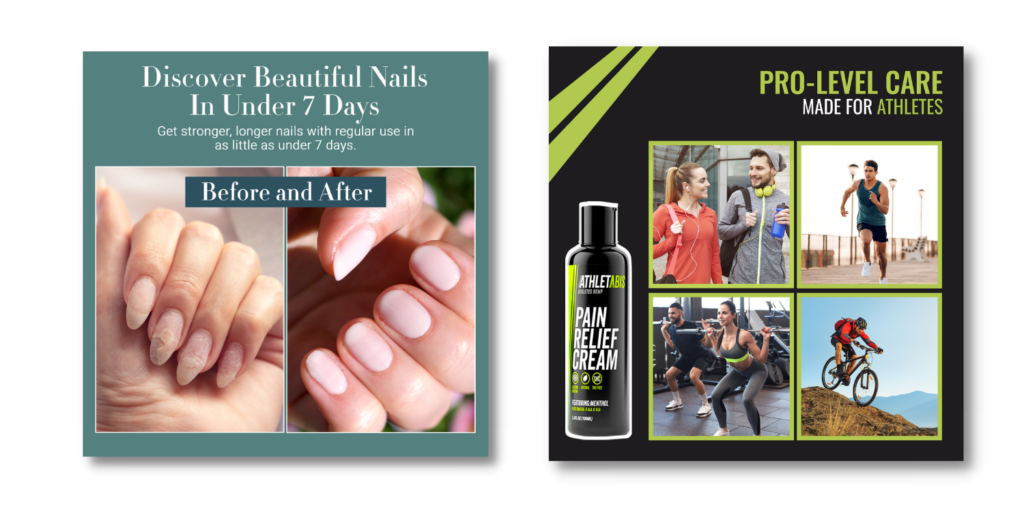
An Amazon product image aims to provide customers with a visual understanding of your product’s appearance, features/benefits, dimensions, and usage. Amazon images help customers make informed purchasing decisions by giving them a clear idea of what the product looks like and how it can fulfill their needs. Amazon allows sellers to upload multiple product images, with the main image being the most prominent one that appears in search results and on the product detail page. In addition to the main image, sellers can include additional images that showcase the product from various angles, demonstrate its features, provide context for its use, and display any variations, such as different colors or sizes.
Amazon images aren’t just factory images or supplier-generated visuals. Crafting compelling images demands time and dedication to ensure they effortlessly engage shoppers and effectively highlight your product’s features and benefits. Amazon product images possess a unique style distinct from those found on other online marketplaces, playing a pivotal role in boosting sellers’ conversion rates.
High-quality, well-lit, and properly composed images that highlight your target market are crucial for making a positive impression on potential buyers and encouraging them to engage with your Amazon listing. The same is true for the Amazon Storefront, A+ Content and Amazon Brand Story sections; images are a driving force of conversion.
How Many Images Can An Amazon Listing Have?
You can include up to 9 images in the Amazon product listing. These images can be a combination of different types, including the main image, infographic images, and lifestyle images. Only the first 7 image are visible, which is why most Amazon listing optimization agencies mainly sell images in sets of 7. Always check the latest Amazon style guides on Amazon Seller Central for the most-up-to-date information regarding number of images and best practises.
Can You Use Other People’s Images on Amazon?
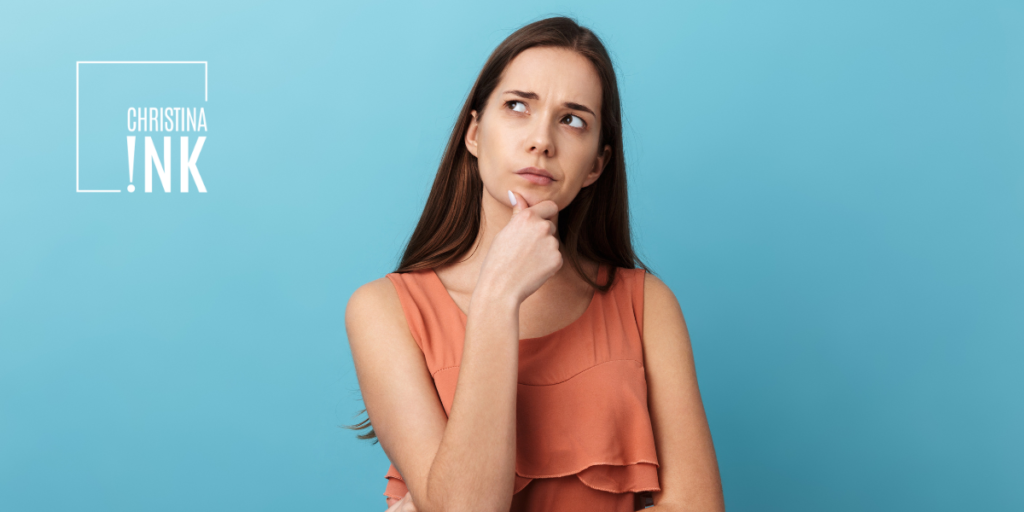
Using other people’s images on Amazon without proper authorization or licensing is considered a violation of copyright and intellectual property rights. It’s important to respect copyright laws and only use images for which you have the appropriate rights or permissions. This can include images of products you’ve manufactured, images you’ve taken yourself, or images you’ve purchased from stock photo websites with the appropriate licensing.
Using someone else’s images without permission could lead to legal consequences, including potential suppression or removal of your listing, penalties, and potential lawsuits for copyright and patent infringement. To ensure you’re in compliance with Amazon’s policies and legal requirements, always use images that you have the proper rights to use or create your own original images.
What is the Best Image Resolution for Amazon Listing?
Image resolution plays a pivotal role in how your products are perceived by potential customers. Amazon recommends a minimum resolution of 1000 pixels on the longest side, but for the best results, aim for a resolution of 2000 x 2000 pixels. This ensures that your images are sharp and clear, allowing customers to zoom in and examine your products in detail. High-resolution images create a sense of professionalism and trust, enhancing your brand’s credibility.
Stick to PNG or JEPG formats, but keep source files on hand to edit your Amazon product images down the road. Most graphic designers offer source files for an upgrade fee, but here at Christina ink we include them free in every Amazon image package.

Why Are My Amazon Listing Pictures Blurry?
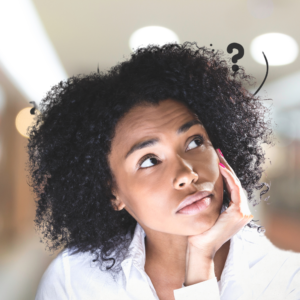
Blurry images can stem from using low-resolution photography or resizing images without maintaining the original aspect ratio. Blurriness also occurs when images are stretched beyond their natural dimensions. To combat this, always use images with the recommended resolution, and be cautious when resizing them. Check for compression settings when saving images to prevent loss of quality.
How Do I Optimize Amazon Product Images?
Optimizing Amazon product images is a crucial aspect of a successful Amazon marketing strategy. To enhance your product listings, start by ensuring that your images are high-quality, well-lit, and showcase your product from various angles.
Adding zoomable images can provide potential buyers with a closer look at your product. Incorporate informative, keyword-rich copywriting hooks and SEO-rich backend alt text to improve search visibility. To boost conversions, consider using lifestyle images that demonstrate the product in use and highlight its benefits.
Always adhere to Amazon’s style guidelines and be consistent in your image style across your entire product catalog. By following these practices, you can effectively optimize your Amazon product images and increase the appeal of your Amazon listing to potential customers.
How to Design Amazon Product Images?
Designing compelling Amazon product images is an art that goes beyond mere visuals—it’s about captivating your audience and inspiring them to make a purchase. That’s exactly why we here at Christina Ink craft a personalized Amazon image strategy to craft the best images for our clients. Here is an overview of what an Amazon image strategy can look like:
Step #1 Outline: Understanding your products benefits and differentiating points is the first step in Amazon image creation along with organizing your content and creating a strategy or project brief. Open a Google or Word document. Start by creating a projected timeline of deliverables; ensure your timeline is realistic.
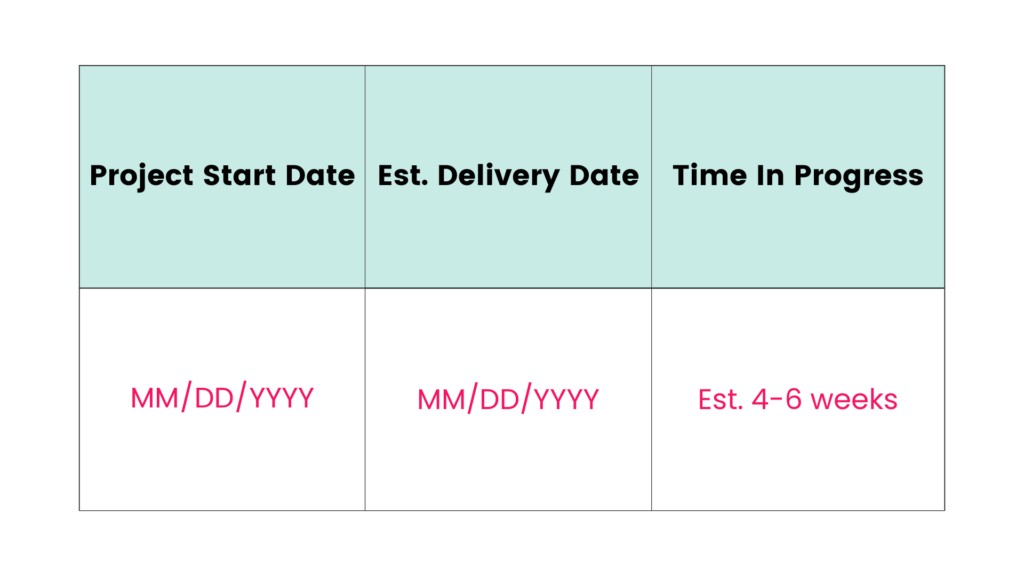
Get crystal clear on what people love about your product and the transformation shoppers can anticipate. Outline any frequently asked questions and relevant details that can help you when you begin to create each Amazon image.


Next, outline your products top ten features and benefits and organize how you want to articulate those features and benefits in each image. Each Amazon image should focus on 1-2 features and benefits per image.
You don’t want to confuse shoppers with multiple features and benefits in every image. Effective graphic design is an art where balance an symmetry must be considered especially on Amazon where every second counts.

Step #2 Competitors: Review your competitors Amazon images. Notice the type of content they leverage. Do you see any comparison charts, how to images, what’s included, etc? Research what customers are saying in competitor reviews. Do their images accurately portray the product? Don’t forget comparison charts, how to explainer images, and before and after images to help quell any customer doubt.

Step #3 Catalog: Build a catalog of Amazon images that in your opinion help clearly define your product’s biggest benefits and features. Screenshot these images and save them directly in your Amazon image strategy document. These images are your baseline.
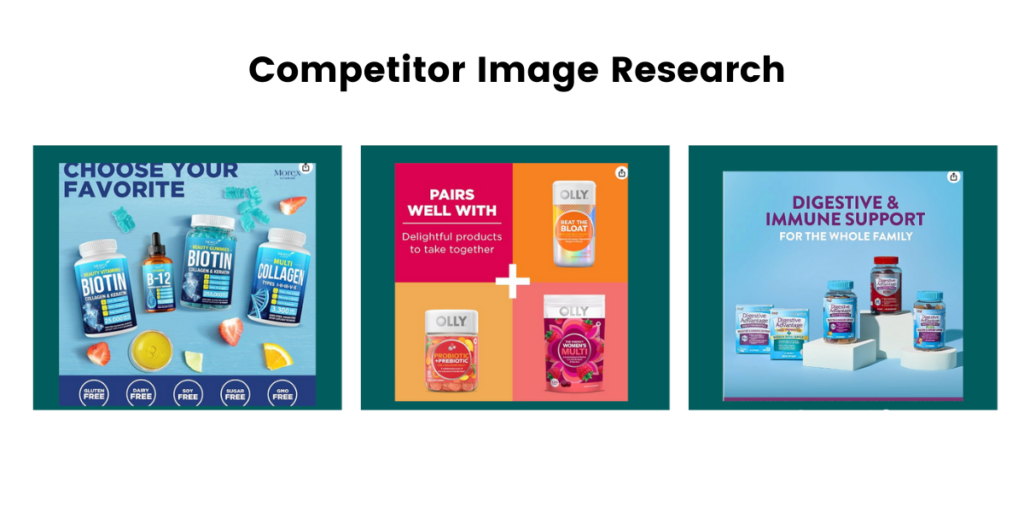
Step #4 Copywriting: Once you have your baseline images recorded and relevant product features, benefits and transformation highlighted, you can start drafting the copy for each image.
Copywriting should be concise and open-ended to pique customer curiosity. Avoid generic statements that don’t evict action, and consider leveraging some of your tag lines or slogans from your website.
Keep fonts consistent and downcase text where possible so that the content is visually appealing. Include relevant measurements, ingredients, and feature call-outs to help draw attention to unique product attributes. Every small detail counts, even with text.
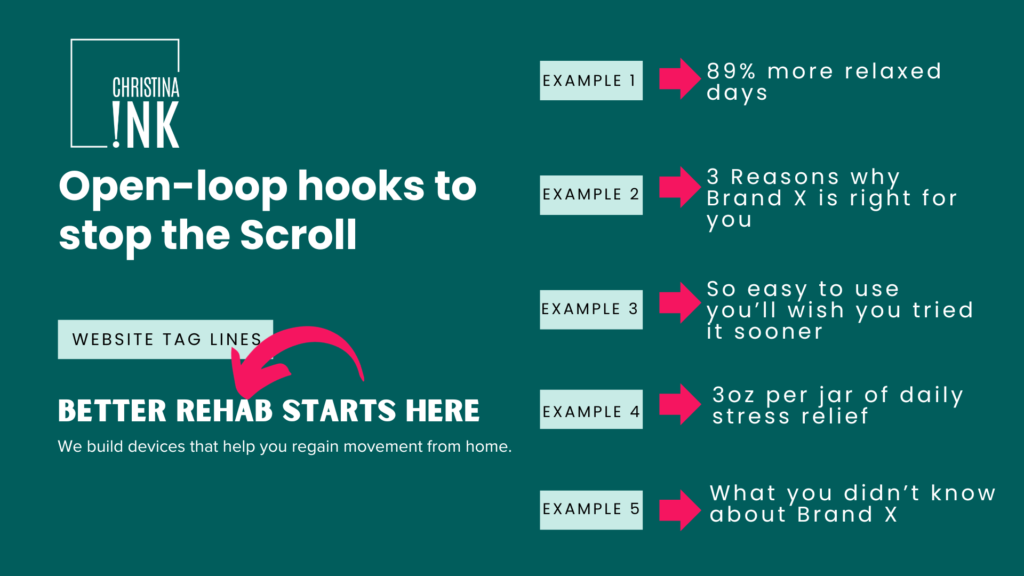
Step #5 Brand Theme: Before you take your image strategy for development you need to craft a unique brand theme that differentiates you from your competition. Notice the colors your competitors are using in their Amazon product detail page, how can you stand out?
Research color theory to help highlight your biggest brand and product attributes. For example, green and yellow may signify harmony, calmness and luxury. Where as black and gold may signify power and abundance. Pro Tip: Consider maintaining your brand guide to help customers easily recognize your brand on and off of Amazon.
Step #6 Image Order: You’re ready to sell, and in your anticipation you hit upload without much thought to the order of your Amazon images. But doing so can be a big misstep to your sales and customer satisfaction. That’s why taking a pause before hitting upload is necessary. Check out our Amazon image order suggestion:
#1 Main Image: Also known as the thumb and hero image.
#2 Transformation Image: Leverage a lifestyle image with brand stamps to draw attention to your target market. Show their anticipated transformation in this image, so they feel compelled to buy now.
#3 What’s Included Image: Customers are more likely to scroll away if they can’t quickly unlock the contents of their purchase. Highlight what they get in the 3rd or 4th image. Remember to display any bonus items such as carrying bags or accessories, but don’t embellish or you’ll set shoppers up for disappointment.
#4 How Does It Work: Outline clear step-by-step instructions so customers know how easy your product is to use. This image may or may not utilize lifestyle photography.
#5 The Perfect Gift: If your product is gift-able, highlight it in image 5 or 6. Try a lifestyle image to showcase happy people during popular occasions and holidays like Christmas, Birthdays and more.
#6 Comparison Image: Tell shoppers why your product is the superior option directly in this image. Generic comparisons are permitted. We don’t suggest lifestyle photography for this image, but be sure to highlight your product somewhere in the frame.
#7 Upsell Image: Many brands offer a range of products, so what better way to drive traffic to those listings buy upselling them in your final Amazon image. Lean on lifestyle imagery with your products in use, to highlight customer satisfaction.
Step #7 Editing: You’ve probably come across Amazon images with glaring typos. Well, the cold hard truth is that typos and literals are conversion-killers. Even if you’re 1000% confident your images are error-free, its wise to have a second set of eyes review each image meticulously. Amazon images riddled with grammatical errors lose trust of discerning shoppers who have thousands of other options at their finger tips.
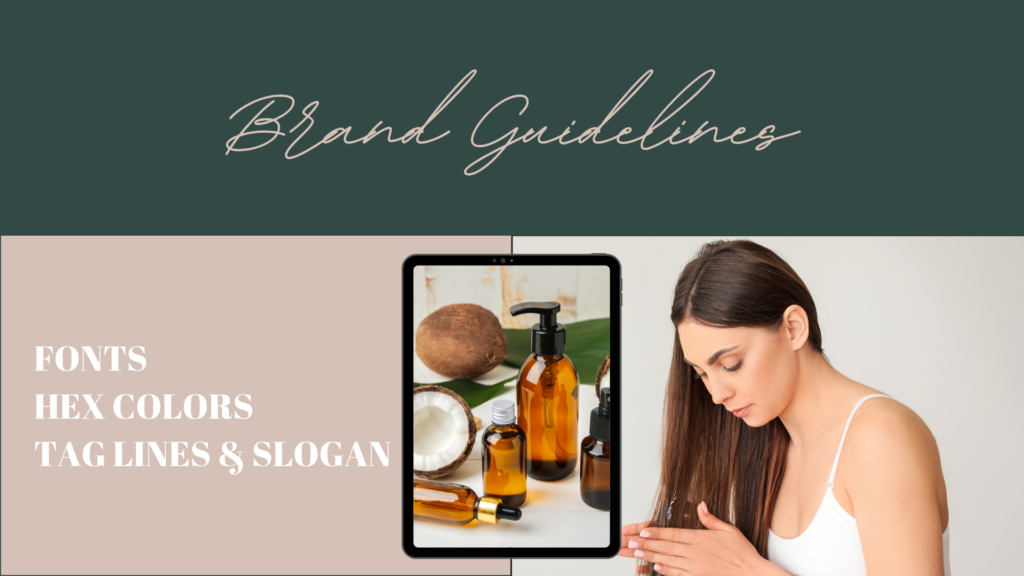
Now you’re ready to hire a freelancer or an Amazon listing optimization service to make your vision come to life. The nice thing about choosing Christina Ink to optimize your Amazon digital shelf is that we tailor a comprehensive Amazon image strategy to meet your needs, so you can focus on other important areas of your Amazon FBA business.
What is An Amazon Lifestyle Image?

An Amazon lifestyle image is a type of product image that showcases a product being used or incorporated into a real-life scenario. Lifestyle images aim to provide potential customers with a visual representation of how the product can fit into their daily lives or fulfill specific needs by illustrating its features, benefits, and potential uses.
For example, if you’re selling a hot air brush, a lifestyle image might depict a woman drying her hair with the hot airbrush, showing the size, and functionality of the brush. One of the best ways Amazon sellers can access affordable high-quality lifestyle images is through User-Generated Content (UGC). Now more than ever shoppers look to resonate and connect before purchasing. Seeing their demographic in UGC can help inspire them to purchase rather than scroll away. The best part is that UGC is affordable and often quick for creators to submit.

Lifestyle images can convey emotions, aspirations, and solutions that your product offers, making it easier for customers to relate to the product and its potential value to them. Amazon encourages the use of lifestyle images to enhance product listings and engage customers more effectively. When creating lifestyle images, it’s essential to ensure that they are of high quality, well-lit, and accurately represent the product and its benefits in a relatable context.
How Do I Make My Listing More Visible on Amazon?
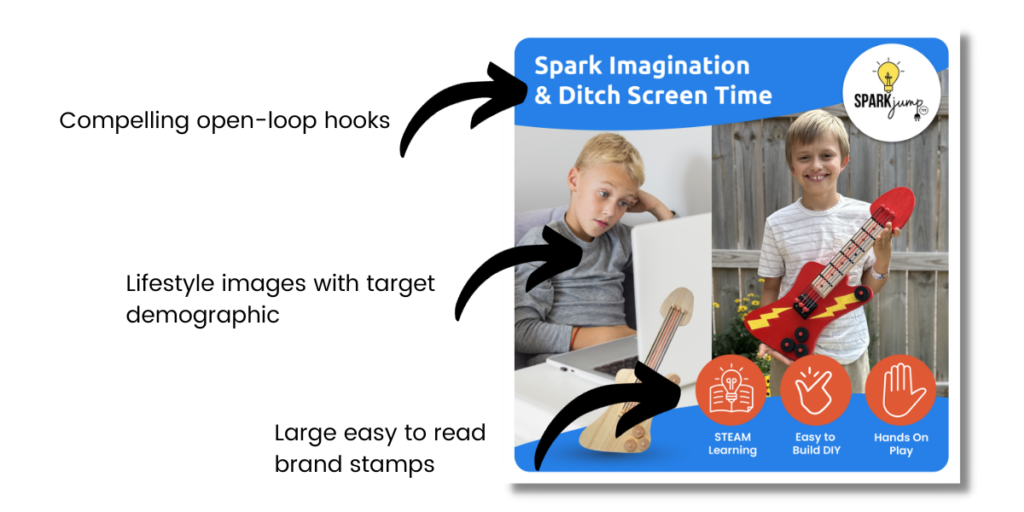
Enhancing the visibility of your listing images involves strategic optimization but may also require advanced SEO. There is an on-going debate in the Amazon community about wether or not keywords are effective in Amazon images. We suggest leveraging keywords and phrases in your Amazon images so long as the text is readable. Certain sections of the listing like the A+ Content offer backend alt text options which are a great place to add keywords.
In 2024, Amazon SEO is pivotal to your success. Having said that, readable images that are easy to scan and visually appealing are your primary goal. Here are some other tips to help boost visibility of your Amazon images:
- #1 High-Quality Main Image: Your main image is your product’s first impression. Use a high-quality image that clearly shows the product and highlights its features.
- #2 Lifestyle and Context Images: Incorporate lifestyle images that show the product in real-world scenarios. These images help customers envision how the product fits into their lives.
- #3 Infographics and Callouts: Use infographics and callouts to convey essential information quickly. These visual aids can explain product features, benefits, and usage.
- #4 Mobile Optimization: Ensure text is large and readable, and any brand stamps are easy to view. Test the zoom in feature before upload so you can get a sense of how the text and visuals may display. With more and more people shopping on mobile, mobile optimization is crucial to your success.
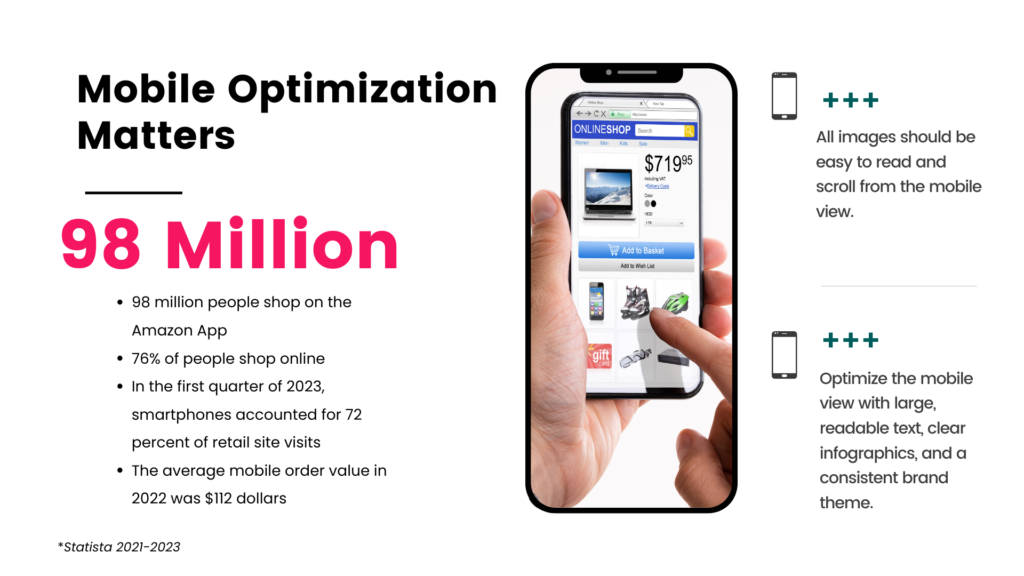
#5 Amazon Brand Story and A+ Content: Take advantage of Amazon’s A+ Content and Amazon Brand Story features to create enhanced product descriptions with clickable links, additional images, text, and multimedia. These sections can further engage customers and boost your conversions.
What is the Image Requirement for Amazon Listing?
Amazon has specific image requirements to maintain a consistent shopping experience for customers. See the chart below for some of the most common image requirements. When in doubt search Amazon Seller Central for Amazon image requirements to keep up to date.
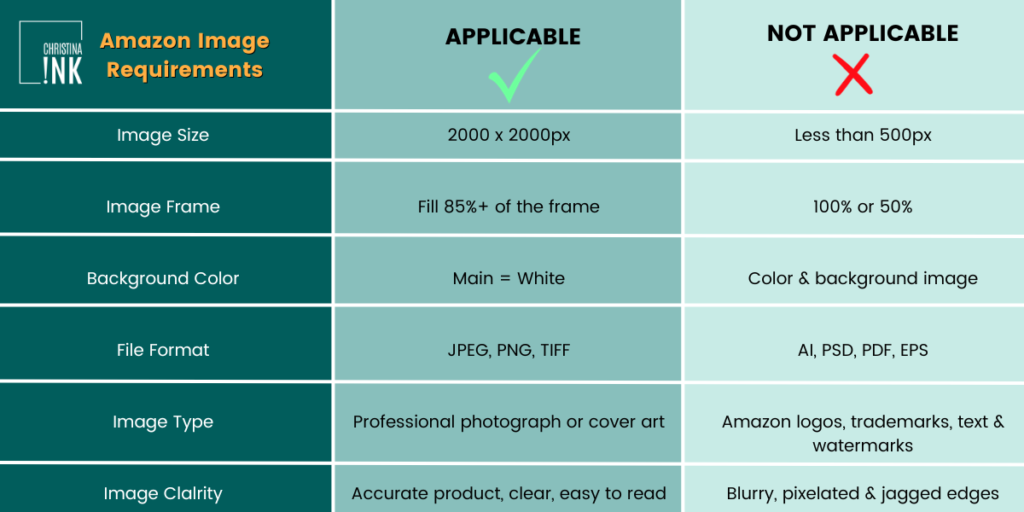
What Is the Best Image for the Amazon main?
Your Amazon main image is the virtual handshake between your product and potential customers. It sets the tone for the entire browsing experience. You’ll want to create a few different hero images so you can split test them with services like PickFu before upload. Unlocking the best hero image with a realistic audience can go a long way in projecting CTR’s.
Let’s review some Amazon thumb image best practises below:
- Showcase Your Product Clearly: Your main image should offer a crystal-clear representation of your product. Choose an image that displays the item from a flattering angle, focusing on its most distinguishing features. Whether it’s a beauty tool, a gadget, or a kitchen product, make sure customers can quickly understand what they’re looking at. Avoid adding Multi Pack badges, or other products in your main image that are not sold with the product at hand. These small infractions violate Amazon’s Code of Conduct and can mean your listing is suppressed or removed.
- Leverage The Power of A White Background: Amazon’s guidelines emphasize the use of a white background for main images. This clean and uncluttered backdrop directs all attention to your product, creating a professional and trustworthy impression. Keep the focus on your item by ensuring that the background is plain and free from distractions.
- Fill the Entire Frame: Maximize the use of the image space by ensuring that your product takes up the frame of the image. Customers should be able to see the product’s details without having to strain their eyes or zoom in. However, avoid extreme close-ups that might hide context or make the product unrecognizable.
- Add Context and Scale: While the main image should primarily feature the product, adding context can be valuable. For instance, if your product is a kitchen appliance, show it in a kitchen setting to help customers visualize how it fits into their daily life. Additionally, consider using an image that portrays the product being used by a person to provide a sense of scale.
- Ensure High-Quality and High-Resolution: Nothing undermines your credibility more than a pixelated or blurry main image. Ensure that your image is high-quality and meets Amazon’s recommended resolution standards. This not only enhances the image’s appearance but also conveys professionalism and attention to detail.
- Try Multiple Iterations: If your product has multiple angles, features, or colors, consider creating additional main images to showcase your product in a variety of ways. Split testing can help you make an informed decision and reduce uncertainty about which main image is most effective. Amazon provides data on click-through rates and conversions, enabling you to make data-driven decisions about which image is most effective.
- Ensure Compliance with Amazon’s Guidelines: Amazon has specific guidelines for main images, including size, format, and the absence of text, logos, and watermarks. Adhering to these guidelines is essential to prevent your image from being rejected or your listing from being suppressed.
How Much Does Amazon Product Image Optimization Cost?
As former Amazon sellers, we understand that cost is a major factor in your Amazon listing optimization efforts. But truth be told, high-quality Amazon graphic design is not cheap. You can find lower level work on freelance sites like Fiverr. But be prepared to spend an excessive amount of time providing comprehensive instructions, and revising your images countless times before final approval.
High-quality Amazon graphic design from reputable agencies ranges starting at $450-750 USD for 7 Amazon images. Be prepared to spend roughly $950 on A+ Content and another $500 for the Amazon Brand Story. To optimize all 3 components of the Amazon listing, you’re looking at close to $2000 USD. Lucky for you, Christina Ink offers free AI listing copywriting and free advanced keyword research in every Amazon image purchase.
Consider the cost of Amazon product image optimization as a business expense. After all, images are what drive sales along side a great product and effective Amazon SEO. Don’t skip out on the most important elements of listing optimization, or your competitors may sweep your market.
Quick Recap: What to Avoid
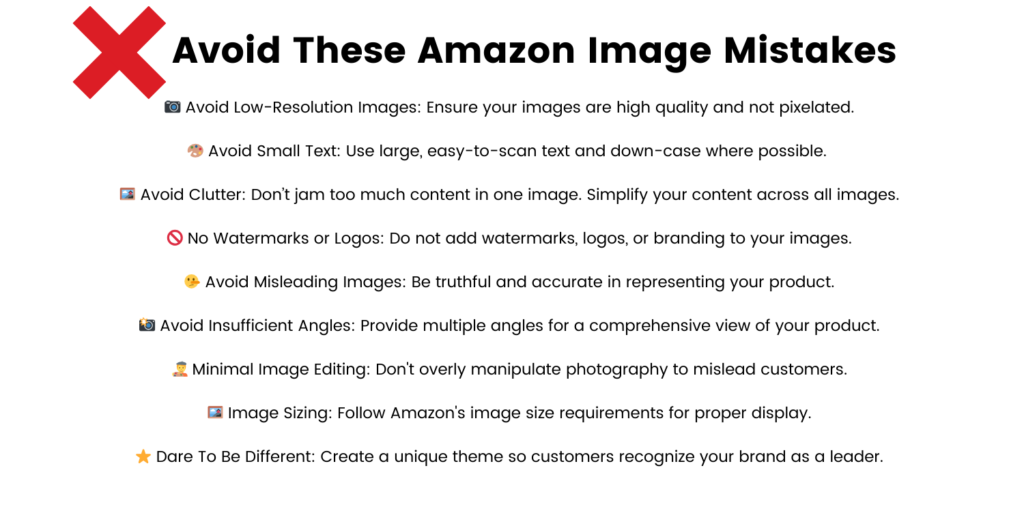
Conclusion
By thoughtfully crafting an Amazon product image strategy you can showcase your product’s best features and benefits to unfold a compelling brand story that drives shoppers to click add to cart. The small details matter in Amazon graphic design, and why thoughtful consideration can prove the best results. If using AI to draft your Amazon images, its best to consult an experienced graphic designer who can add visually appealing elements like text overlays, brand stamps and copywriting hooks.
Through meticulous attention to detail, strategic storytelling, compelling copywriting, and a keen eye for aesthetics, Christina Ink creates images that resonate with your target audience. With our support, you’re not just optimizing Amazon product images; you’re shaping a brand story that compels customers to browse, but most importantly buy. Contact Christina Ink today to embark on a visual transformation that can redefine your Amazon selling success.

LIKE THIS ARTICLE?